Eating rare lamb is controversial, as opinions range from highly recommended to wholly discouraged. Lamb is a red meat that can be served in various ways: grilling, roasting or sautéing. However, the debate becomes more heated when it comes to eating lamb rare. Many people are unsure whether this cooking method is safe or not and if it affects the flavor and texture of the finished product.
To answer the question: Can you eat lamb rare? We’ll look at all the factors involved when determining whether this cooking method suits you and your family.
Understanding Lamb Cooked to Rare
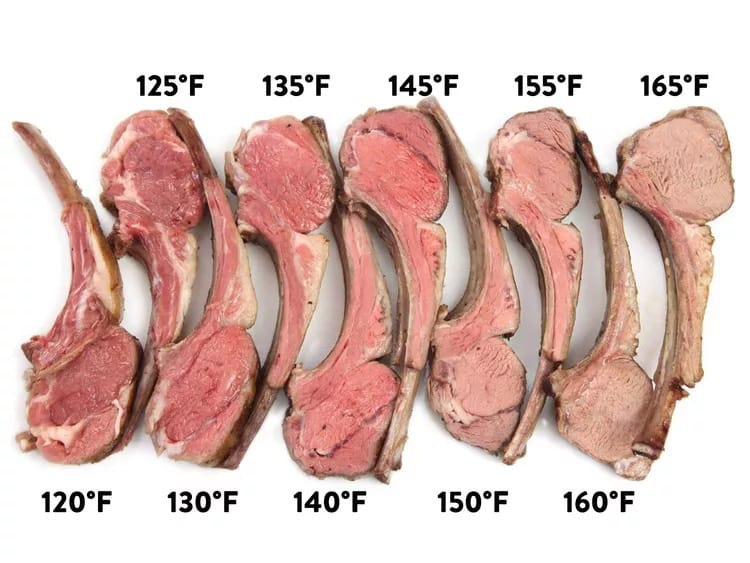
The best cuts are typically from the leg and shoulder when cooking lamb to rare. These cuts tend to be the most tender and flavorful. The leg is commonly used for roasts, and the shoulder is often used for braising or stews. The loin is also popular for rare lamb recipes, but cooking it correctly can be slightly more challenging.
When cooking lamb to rare, the ideal temperature is 130-145°F (54-58°C). Any lower than this, and the lamb may not cook through properly. Any higher and the meat will become tough and dry. A meat thermometer is important to ensure you’re cooking the meat correctly.
There are a few tips to keep in mind when it comes to serving. First, it’s important to let the lamb rest after cooking. This helps the juices to be reabsorbed and helps to keep the meat juicy and tender. Another tip is to slice the lamb thinly and serve it with a sauce or gravy to prevent it from drying out. Finally, avoiding overcooking is essential, resulting in dry and tough meat.
Can You Eat Lamb Rare?
Lamb is a delicious meat that many people enjoy, cooked rare or medium rare. According to factual data, consuming lamb at cooler internal temperatures is safe, as most bacteria that can cause illness are concentrated on the surface. Although some may be cautious about eating lamb that is not fully cooked, the risks of getting sick from rare or medium-rare lamb are low.
However, it is crucial to ensure that the lamb is cooked to a minimum internal temperature of 145°F to prevent any potential health risks. Eating the lamb raw is also unsafe, as bacteria will not be killed off. As long as the lamb is cooked correctly and at the right temperature, it can be a delicious and safe addition to any meal.
Can You Eat Lamb Leg Steaks Rare
Lamb leg steaks are a delicious and tender cut of meat that many people enjoy. But can they be eaten rare? The answer is yes! While it is important to ensure that the meat has reached an internal temperature of at least 145°F, lamb leg steaks can be cooked and served rare or medium-rare for the tastiest and juiciest results.
When cooking, gently press with your thumb to test for firmness – the more spring back you get, the hotter the protein cells have expanded. If you’re unsure, it never hurts to ask your butcher for advice on cooking and serving lamb leg steaks rare.
Is it Safe to Eat Lamb Rare or Medium Rare?
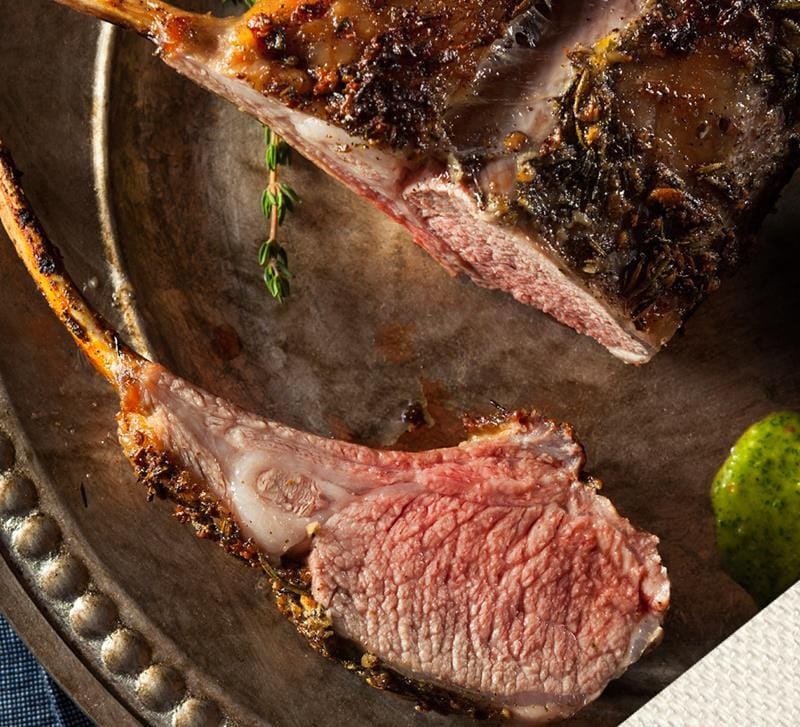
The good news is, yes, it is safe to eat lamb rare or medium rare. However, it would be best if you kept a few things in mind before doing so.
First and foremost, you must purchase high-quality, grass-fed lamb from a reputable source. Grass-fed lamb is much leaner than grain-fed, requiring less cooking time to achieve the desired level of doneness.
It’s also important to note that lamb should be cooked to at least 145°F, as this will ensure that any potential bacteria have been killed. For medium rare, the internal temperature should reach about 160°F.
Finally, it’s recommended that you rest the meat for a few minutes before slicing or serving it. This will allow the juices to redistribute evenly, resulting in a juicy and flavorful cut of lamb.
Read more:
What Are The Cuts Of Lamb Suitable For Rare Or Medium-Rare Cooking?
When it comes to cooking lamb, one of the key factors is selecting the right cut. The cuts of lamb suitable for rare or medium-rare cooking include:
- Lamb Loin: This is a lean, tender cut of meat that is ideal for roasting. Lamb loin is best served rare or medium-rare.
- Lamb Chops: Lamb chops are another great option for rare or medium-rare cooking. They are usually cut from the rib section of the lamb and can be served either grilled or fried.
- Lamb Shoulder: Lamb’s shoulder is tougher than the other cuts but makes a great rare or medium-rare meal. It is usually cooked in a slow cooker or braised.
- Lamb Leg: The leg is a large cut of meat and is perfect for roasting. It is usually served medium-rare but can be cooked to rare doneness if desired.
When cooking lamb, it is essential to remember not to overcook it as it can become tough and dry. Be sure to monitor the internal temperature of the meat to ensure that it is cooked to the desired doneness.
How Should Lamb Be Prepared To Ensure It Is Safe To Eat When Served Rare?
When preparing lamb, there are many ways to ensure it is safe to eat when served rare. The most important factor is to ensure that the lamb is of high quality. Quality lamb will be fresher, have a better flavor, and be safer to eat.
- The first step in preparing lamb for rare consumption is to ensure it is cooked to an internal temperature of at least 145°F. This temperature kills any bacteria or other organisms that can cause foodborne illness. Additionally, it is important always to follow the cooking instructions that come with the lamb.
- The next step is ensuring the lamb is properly trimmed and trimmed of any fat or sinew. Trimming the meat not only yields a better result but also helps to reduce the fat content, which reduces the risk of foodborne illness.
- When cooking the lamb, it is important to cook it evenly. This means the meat should be cooked on all sides, not just one. This prevents the meat from becoming overcooked or undercooked on one side. Additionally, it is important to use a thermometer to ensure that it is cooked to the desired temperature.
- When preparing the lamb, using fresh herbs and spices is essential. Herbs and spices help to bring out the flavors of the meat and can also help to reduce the risk of foodborne illness. Additionally, it is essential to season the meat lightly so as not to overpower the natural flavors of the meat.
- Finally, ensuring the lamb is served immediately after being cooked is important. When the lamb is served cold, it can cause foodborne illness, so it is important to serve it promptly.
Is There Any Difference Between Cooking A Lamb Chop Or Leg Of Lamb If You Intend To Serve Them Rare?
Is there any difference between cooking a lamb chop or leg of lamb if you intend to serve them rare? The short answer is yes. There is a difference. Lamb chops are typically cut from the rib section of the animal and are often sold with the rib bone still attached. They are usually quite small and are often cooked and served in individual portions.
On the other hand, the leg of lamb is a larger cut of meat taken from the upper part of the leg. It is usually sold as a whole, boneless piece of meat and is often served as a large joint, either real or cut up into individual portions.
When it comes to cooking, the difference between lamb chops and leg of lamb is that lamb chops can be cooked quickly, usually in a matter of minutes, while a leg of lamb will require a longer cooking time. This is because the leg of lamb contains more fat and connective tissue, which requires a longer cooking time to break down and become tender.
The Risks of Eating Lamb Medium Rare
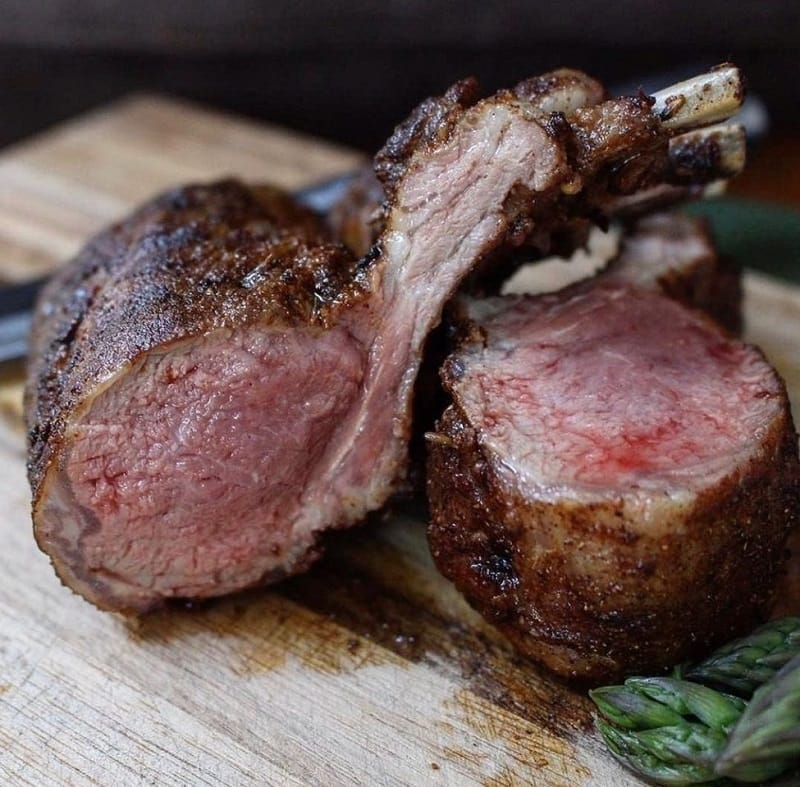
Many people consider medium-rare lamb one of the safest and most delicious ways to enjoy meat. However, some risks are also associated with consuming it in this manner.
- First of all, there is a risk of bacterial contamination. Lamb is a source of protein, which is why it is so important to cook it thoroughly. When meat is cooked at a lower temperature, it can allow bacteria to survive and potentially cause food poisoning. It is important to ensure that the meat reaches a safe internal temperature of at least 145°F to avoid food-borne illnesses.
- Another risk of eating lamb medium rare is the potential for parasites. Lamb can be a source of parasites, most commonly roundworms, which can be present even in the best-raised animals. It is important to make sure that the meat is cooked to a safe internal temperature to kill any parasites that may be present.
- Finally, there is the risk of consuming too much-saturated fat. While the lamb is a lean protein, it is also very high in fat. Overeating lamb cooked medium rare can increase the risk of developing heart disease and other health conditions. For this reason, it is important to limit your consumption of lamb cooked medium rare and to focus on leaner cuts of the meat.
How Long Does It Take To Cook A Leg Of Lamb So That It Can Be Served Rare Safely?
If you’re looking to cook a leg of lamb and serve it rare, it’s essential to know how long it takes to cook it safely. Based on factual data, it typically takes at least 2 hours of roasting in a preheated oven at 425°F to reach a temperature of 135°F, which is considered rare. However, it’s important to note that the lamb will continue cooking as it rests outside the oven, so it’s recommended to take it out at 135°F for medium-rare to medium.
For a boneless leg of lamb, it takes about 5 hours and 45 minutes to slow roast it. To achieve rare doneness, the lamb should be roasted for 1 hour and 40 minutes at 375 degrees F.
Why Bacteria Concentration Matters?
When preparing lamb, it’s essential to take the time to make sure it’s cooked thoroughly. If the internal temperature of the meat doesn’t reach at least 145 degrees Fahrenheit, bacteria like E. coli, Salmonella, and Clostridium perfringens can remain alive and cause foodborne illness. Cooking lamb to an internal temperature of 145 degrees Fahrenheit is especially important if it’s cooked rare or medium-rare.
When preparing lamb rare, paying attention to the number of bacteria present is essential. Bacteria can build up on the surface of the meat, and the longer it sits at room temperature, the more bacteria it can accumulate. This can create a situation where the bacteria concentration is higher than it should be, leading to a higher risk of foodborne illness.
To reduce the risk of foodborne illness, refrigerate the lamb as soon as possible after it’s been cooked. This will help to slow the growth of bacteria and reduce the risk of illness. It’s also important to use a food thermometer when cooking lamb – this will ensure that it’s been cooked to a safe internal temperature.
Eating lamb rares can be a great way to enjoy the unique flavor of the meat, but it’s essential to pay attention to the bacteria concentration of the lamb. By refrigerating the meat as soon as possible after cooking and using a food thermometer to check the internal temperature, you can reduce the risk of foodborne illness. So, the next time you enjoy lamb, remember these tips.
Enjoying Lamb Served Rare: Factors to Consider
Enjoying lamb served rare can be a delicious and flavorful experience, but it is important to consider a few factors for safe consumption.
Lamb should be cooked to a minimum internal temperature of 145°F (63°C) to avoid harmful bacteria like E. coli. However, rare lamb is generally safe to eat if it has reached an internal temperature of at least 115-120°F.
It’s important to note that lamb is best served rare to medium-rare, as roasting or slow cooking can lead to drying out the meat. Enjoying leaner and more tender cuts of lamb rare can bring out the natural sweetness of the meat, which won’t have as much of an impact on blood sugar levels as other meats can.
Overall, while there are risks associated with undercooked meat, lamb served rare can be a delicious and safe option when prepared correctly.
The Importance of Using a Thermometer
A thermometer helps ensure that your lamb is cooked to the proper internal temperature. This is important because different parts of the lamb have different recommended temperatures. For example, a lamb shoulder should be cooked to an internal temperature of 160°F, while a leg of lamb should be cooked to an internal temperature of 145°F.
Using a thermometer also helps prevent over-cooking. Lamb is best-served medium-rare (cooked to an internal temperature of 130-135°F). When cooking a thick cut of lamb, it’s easy to overshoot the ideal temperature. But with a thermometer, you can monitor the temperature as you’re cooking and pull the meat off the heat when it’s done.
In addition to using a thermometer to monitor the lamb’s temperature, it’s also essential to allow the meat to rest after it’s been cooked. This allows the juices to redistribute throughout the meat, ensuring maximum juiciness and flavor.
So, investing in a good thermometer is necessary if you cook lamb. A thermometer will help you ensure your lamb is cooked to the proper internal temperature, preventing it from being undercooked. Allowing the meat to rest after cooking is also a good idea, ensuring maximum juiciness and flavor. With a thermometer and a few other tricks, you can enjoy perfectly cooked lamb every time!
What Kind Of Spices Or Marinades Complement Rare Lamb?
Choosing the right spices and marinades is important to truly enjoy the flavor of rare lamb. When it comes to spices, the most popular choices for rare lamb are garlic, rosemary, and thyme. These herbs provide a subtle flavor and aroma to the meat while still allowing its unique flavor to shine through. You can also add some black pepper or cumin to add a bit of heat to the dish.
When it comes to marinades, a few options work well. Soy sauce, Worcestershire sauce, and balsamic vinegar all add great flavor to the lamb. You can add some honey, mustard, and olive oil for a zesty flavor.
If you’re looking for something more adventurous, you can also try Chinese five-spice powder or Indian curry paste. These provide a unique flavor and add some extra kick to the dish.
No matter what spices or marinades you choose, the most important thing to remember is not to overpower the flavor of the lamb. Choose a few spices or marinades and let the lamb’s natural flavor come through.
FAQs
Can People Eat Rare Lamb During Pregnancy Or While Breastfeeding?
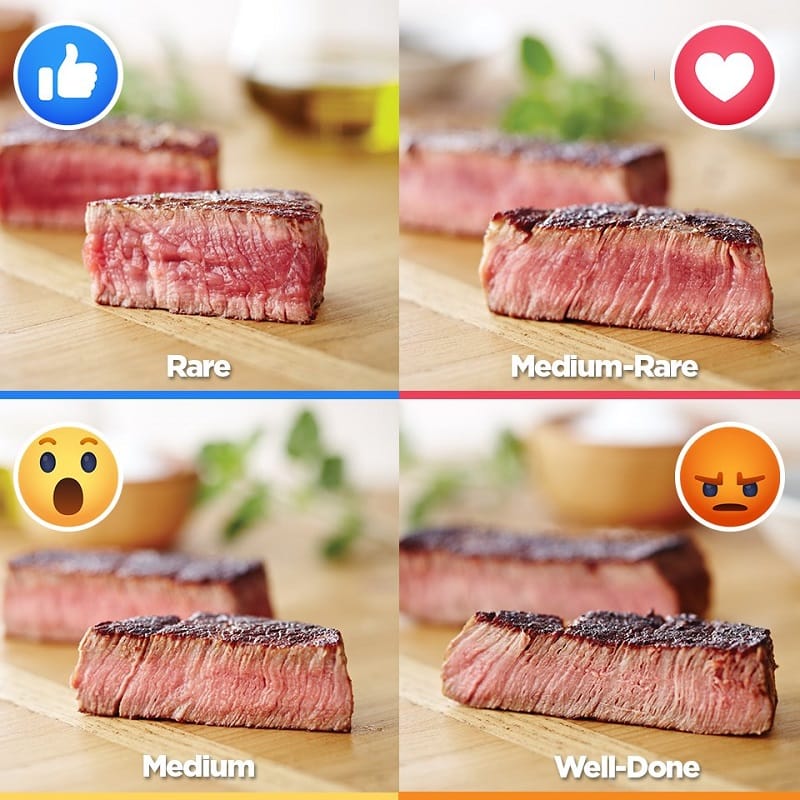
It’s essential to make smart food choices during pregnancy and breastfeeding to ensure the health of both mother and baby. While lamb can be a nutritious and tasty addition to a balanced diet, serving it cooked rather than rare or undercooked is essential. Consuming undercooked meat during pregnancy may lead to foodborne illnesses and potentially harm the developing fetus.
However, eating moderate amounts of lamb during breastfeeding is considered safe and can even increase milk production thanks to its high iron content. Overall, enjoying lamb in moderation while following safe cooking practices is a great way to add variety and nutrition to a pregnancy or breastfeeding diet.
What Types Of Wine Pair Well With Rare Lamb Dishes?
When it comes to pairing wine with rare lamb dishes, there are a variety of options to choose from. Light red wines like Gamay or rich white wines like Semillon can be great choices. However, Bordeaux red blends and Pinot Noir are the most commonly recommended wine pairings for rare to medium-rare prepared lamb racks. These wines lead with red fruit flavors and complement the delicate flavors of the rare lamb dishes well.
It is also important to consider the accompanying dishes when selecting a wine. A fruity, slightly porty red like Douro red or Zinfandel can also work if the dishes are not too hot.
What Temperature Should The Internal Temperature Of A Rare Lamb Dish Reach For It To Be Considered Safe For Consumption?
Ensuring it is safe for consumption is of utmost importance when cooking lamb. According to the official guidelines set by the USDA, a rare lamb dish should have an internal temperature of at least 145°F to be considered safe to eat. It is always recommended to use a food thermometer to check whether the meat has reached the proper temperature, which should be allowed to rest for at least 3 minutes.
While some may prefer their lamb to be cooked to a different degree of doneness, it is crucial to prioritize food safety above personal preferences. Following these guidelines, lamb dishes can be enjoyed with peace of mind and without worrying about potential health risks.
Are There Any Methods For Keeping The Meat Tender While Still Ensuring Its Safety When Served Rare?
When serving rare meat, there are some important considerations to ensure its tenderness and safety. One method for tenderizing tough cuts of meat is physically tenderizing it, such as with a meat mallet. However, cooking it thoroughly to an internal temperature of 145°F with a 3-minute rest time is essential for mechanically tenderized meat. Another method for tenderizing meat is through osmosis, covering it with a dry cure or soaking it in a curing solution.
To ensure safety, it’s important to keep beef below 40°F during storage, uncooked store beef separately from cooked foods, and avoid any meat that appears discolored or has a strong odor. When cooking meat, a digital meat thermometer can help ensure it is cooked to the proper temperature without overcooking while allowing for a rest period of about five minutes to help the meat retain its juices.
Can People Develop Food Poisoning By Eating Rare Lamb?
Yes, people can develop food poisoning by eating rare lamb. Although it is possible to safely consume cooked or medium-rare lamb, risks are involved. Just like other meats, lamb has a higher risk of contamination due to the slaughter process, which increases the likelihood of bacteria being present on the surface of the meat. If the lamb is not properly seared, any present microbes may still be able to cause food poisoning. Therefore, it is important to cook lamb thoroughly to reduce the risk of illness. In the end, the safest route is to cook meat at recommended temperatures and take precautions to avoid the spread of bacteria.
How Long Can People Store Or Refrigerate Raw Lamb To Maintain Its Freshness?
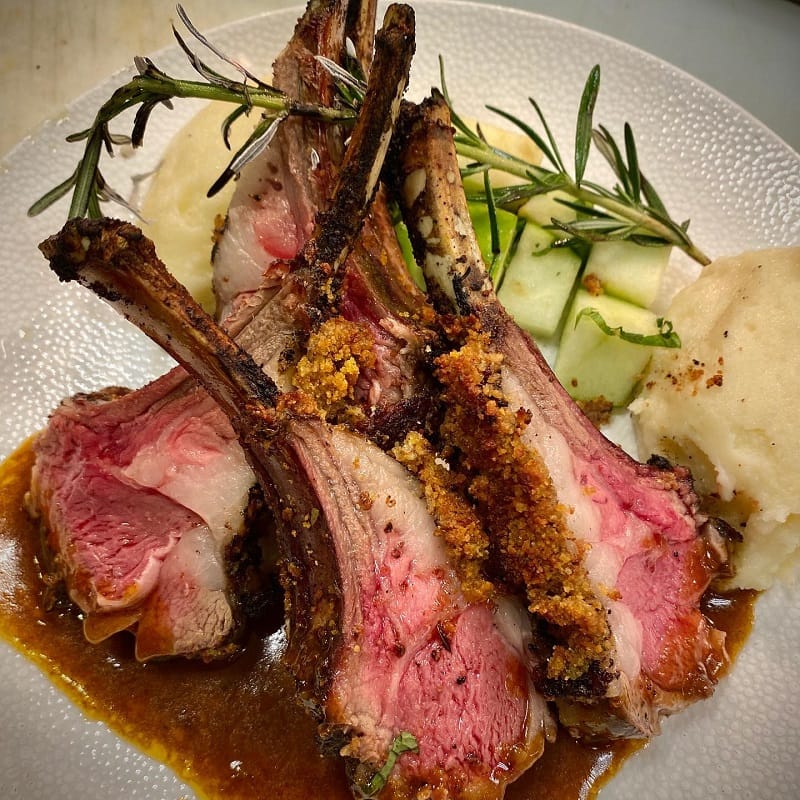
According to factual data, most cuts of lamb can be safely stored in the refrigerator between 33°F and 40°F for two to three days. However, if the lamb roast has been thawed in the fridge, it can be kept for three to five days before cooking. Ground lamb can be refrigerated for up to one to two days, while cooked lamb should be used within three days.
If a trip is planned and needs to transport raw lamb, placing it in a cooler on ice to keep air out and moisture in is recommended. Overall, researchers have found that the optimum time to keep lamb in the refrigerator is two weeks, provided the use-by date is not exceeded, and bacteria growth is prevented. By following these guidelines, people can ensure that their raw lamb stays fresh and safe to consume for as long as possible.
Conclusion: Can You Eat Lamb Rare?
Now that you know if can you eat lamb rare? You can enjoy this delicious meat without worrying about any potential foodborne illnesses. Just be sure to use a food thermometer and follow the proper food safety protocols to keep yourself and your family safe. Enjoy!
References:
https://www.bbcgoodfood.com/howto/guide/how-cook-lamb

Hey readers! Chip Holland here, and I’m a Manager of this website. My passion for writing about it only matches my passion for BBQ. Follow my blog for mouth-watering recipes, tips, and tricks for the perfect smoke, grill, and BBQ. I’m sure you won’t be disappointed!
